#wikipedia is not a trustworthy source
Explore tagged Tumblr posts
Text
Britannica has updated his bio and Wikipedia locked the page so all the editors could argue about whether being a convicted felon is notable… which I realize is the point of Wikipedia but some of the arguments against are… incredibly unprofessional and disconnected from reality, especially since the other major online encyclopedia DID IT ALREADY—it’s both hilarious and why I don’t use Wikipedia as a source.
If people take a day to celebrate your conviction and you don’t consider that notable enough for the first paragraph, I’m perceiving that as a bias and moving to a different, more grounded source.
There is literally a phrase describing this behaviour: burying the lede. When things like this happen (and they do fairly regularly) I see Wikipedia as its own dimension before moving along.
#off topic#not fiber arts#Wikipedia is not a trustworthy source#donald trump#donald trump conviction#us politics#politics
8 notes
·
View notes
Text
That's a lot of effort going in to alter facts for a group that claims to be telling the truth


Source
#wikipedia#censorship#bias#wikipedia bias#palestinian narrative#wikipedia editors#pirate wires#proxy war#russian influence#iran#qatar#wikipedia vandalism#wikipedia is not a trustworthy source#just like your teachers told you#assuming some of you hamasnik goons even went to school#pallywood#occupied wikipedia#antisemitism#systemic antisemitism#i/p conflict#israel#palestine#if anything they claimed was true#they wouldn't be working this hard to change the narrative#am yisrael chai
364 notes
·
View notes
Text

day 1421
#uh just a heads up if you expand the tags to see all there's. a lot. very long#amphibian#frog#poison dart frog#based on my most popular frog to date (day 651)#inspired by everyone pointing out what they think it looks like#here's a fun secret fact the original guy is actually a phantasmal poison dart frog (Epipedobates tricolor)#(according to the original artists title of the drawing)#not Anthony's poison arrow frog (Epipedobates anthonyi)#i feel too awkward to really point it out though because they look the exact same. i cannot tell if there is a difference#im half convinced the same frog was just discovered and named twice#its very curious btw if you go on the (english) wikipedia page for either species it doesn't mention the other#while hereptiles.info (no idea if this is a trustworthy site) lists both names as common names for the same frog (incorrectly??)#while inaturalist lists them as two different frogs. curiously with tricolor having wayyyyy fewer photos#ok anyway that's my rant i went on a whole journey trying to figure out if these are the same frog or not and i have no answer#i did some more 'research' and i am more confused. some sources seem to imply they are now considered the same species ( e. tricolor)#i think my conclusion is i am willing to agree the drawing looks more like e. anthonyi. it seems like tricolor is generally less vibrant re#and the white is darker and more green?#i feel like thumblr should stop me from typing more in the tags at this point this is a whole essay#at this point i am failry convinced this is specifically the Santa Isabel frog. isthat the real subspecies or morph or whatever#or just the name pet sites are using to sell it??#i even found some sources (frog selling websites) refering to it as “Epipedobates Anthonyi 'Santa Isabel' Phantasmal Poison Dart Frog” lol#Anyways if you read this far hi. species are confusing. i am not a frog scientist#the first few tags are like an hour old now i just kept trying to figure it out and adding more tags
3K notes
·
View notes
Text

Oh.
#the band#garth hudson#i'm not a the band fan#but i know some of my mutuals really like them#rip#i'm unsure of whether the toronto star is a trustworthy source since i'm not canadian#and the news are not on wikipedia yet so i'm still waiting to see if this is real#if this turns out to be fake news i'll delete it but if this is real i'll keep this post up
3 notes
·
View notes
Text
One of my college professors: "Don't ever use Wikipedia for school assignments and professional works." My class: "We know." Professor: "I shall prove it. Many years ago a friend and I put a lie about Harrison Ford on Wikipedia and it's still there. People think it's true, to the point that it's been put into official print biographies about him." Me: "If it's become that widespread, shouldn't you, like fess up and remove it?" Other Classmate: "Yeah you're continuing the spread of misinformation. Isn't that kind of unethical?" Me: "Especially since you're teaching a class on preventing misinformation and identifying fraud." Professor: "No, I'm not taking it down, it's funny. And it's Wikipedia, so nobody cares. None of my other classes complained about this in the past."
Of course, now that she finally had a class that's internet-savvy, the factoid is no longer there, presumably removed by one of my classmates. But now you know. There's a "well-known" fact about Harrison Ford that's a complete fabrication. Good luck figuring out what it is!
#academics#wikipedia#college#university#professors#frankly wikipedia would be way more accurate#if all the people who disparaged it for being “wrong” just fixed it themselves#cowards#idk how to tag this#harrison ford#my professor also claimed that we were the first class of hers to not view wikipedia as a trustworthy source#i live in fear of her previous classes
8 notes
·
View notes
Note
It wasn't a random urinal, duchamp made it, something ai can never do

arguably the most important fact about Fountain was that duchamp very much did not make it. nearly every art historian agrees it was a random urinal from a plumbing store and the entire point of the piece was that it was a mundane object that he did not make, elevated to art by the act of simply calling it art. it was about showing that art is not just about literal creation but more importantly about the creation of ideas. is performance art not art? is photography not art? there absolutely exist forms of art where the artist did not craft anything with their hands. i'd argue the fundamental thread behind all art is that it is about conveying ideas, whether that idea is aesthetic, practical, philosophical, absurdist, or anything else in nature. and that was kind of the entire point of the dada movement, to challenge existing notions of what "art" is.



i don't necessarily agree with the dadaists on everything- i have great respect for art as a concept and a cultural keystone, but that is also the reason why i have to acknowledge that anything put forth by humans for no other purpose than to exist and to express a feeling, a message, an idea, is absolutely art and is the thing (in my opinion) that sets us about from animals. so yeah, sometimes that includes ai generated images lmao (even if i have IMMENSE issues with the datamining and anti-worker practices that have quickly taken over nearly all of current ai).
#look you can disagree with me on whether ai art is art but don't come at me with incorrect art history claims that shit a passion of mine#(sources are all wikipedia btw. which is pretty trustworthy for a piece and movement as famous as this.)
2 notes
·
View notes
Text
Shot in the dark, but I have this problem with Google where it keeps wanting to show these information panels when you search my name and getting the completely wrong person. I think Google doesn't have a trustworthy "about" page it can pull info from, so it just guesses a random person with a similar name?
First it was a biologist:

Then a congressman from Argentina:

And now it's a singer?

I've tried giving feedback, claiming the knowledge panel, and nothing seems to work, they just switch to a new identity... I've tried linking them to my own about page and socials but they don't take any information from there either. I guess they need some kind of external "authoritative source" for something like this?
So I'm thinking the only viable solution might be to have a Wikipedia article with a name, photo and basic info so that Google stops making me steal people's identities? I don't think this is fun to any of the people with similar names to me with their own careers who keep getting their search pages invaded by my links... It's getting pretty frustrating.
Does anyone here have any experience with editing Wikipedia and can help me through this? Thank you! (if you can help me, shoot me a DM or message on Discord @ Valdevia)
432 notes
·
View notes
Photo
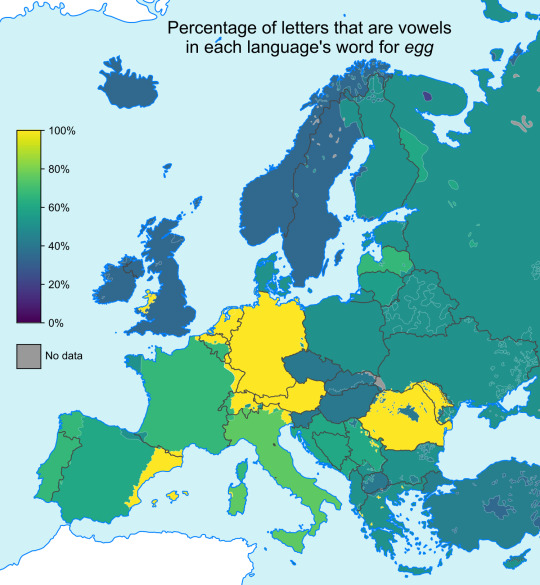
Percentage of letters that are vowels in each language's word for "egg".
by 99685-96-8
To preface: I am not a linguist, so there's a high probability there are some mistakes in this map. Please don't vilify me if I misrepresented your language in this map.
Edit: Friulian should be 50%, not 100%. Updated map.
Here's a version of the map with language labels.
Here's a version of the map with percentage labels.
This map mostly stemmed from a stupid thought in my head, when I realized the Dutch word (I am Dutch) for egg (ei) only consists of vowels. This sparked the question of how this property is distributed across European languages.
One search for a language map later (thanks Wikipedia!) and dozens of searches for translations and alphabets later (there are approximately 60 languages on this map) (thanks Wikipedia and also Wiktionary!) and now we know!
(As "vowel," I defined a letter that can have a vowel sound in the corresponding language. For many languages, it was hard to find pronunciation guides for the specific word while finding a translation was easier, so I decided to focus on letters instead of phonemes. Furthermore, for some languages in the base map, I could not find a trustworthy translation, hence the "no data" for some languages. Digraphs in some Cyrillic alphabets were counted as a single letter.)
Happy Easter!
Main sources:
Base map from Wikimedia Commons
Most translations from Wiktionary
Ladin translation from the Istituto Cultural Ladin
Sámi translations from the Oahpa portal of the University of Tromsø
Scots translation from scots-online.org
501 notes
·
View notes
Text




Sean bienvenidos , arqueojaponólogos; quiero hacer un llamamiento: en Instagram abundan cuentas así como la de la foto que usan Wikipedia sin rigor cientifista y lo peor es que hay gente incrédula, o no sé cómo llamarlos para suavizarlo. Hay que ser crítico con lo que se lee en internet. Si de verdad quieren aprender sobre algo, hay que leer hasta un máximo de 10 fuentes, incluso más, y después contrastar la información que leemos. Las fotos son una cosa aparte, pero también hay que tener cuidado con el material que se usa; yo me tiro días en publicar el contenido que ven en esta cuenta. Además, las fotos son dos recursos muy buenos para detectar el plagio y lo siento mucho por esa cuenta y todas las cuentas que son similares; si las ven, denuncien o bloqueen, no son de fiar, son cuentas que desinforman, además de la poca originalidad. - Hay fuentes más confiables que Wikipedia, como Google Scholar y Academia.edu, por poner unos ejemplos. Si todos unimos fuerzas, podremos eliminar de internet este tipo de gente y su contenido que solo sabe desinformar . - Que pasen una buena semana y nos vemos en próximas publicaciones . ¡Feliz año 2025! - ようこそ、日本考古学者の皆さん。訴えたいのですが、インスタグラムには写真のようなアカウントが科学的厳密性なしにウィキペディアを利用しているアカウントがたくさんありますが、最悪なのは信じられない人がいるということです。あるいは、彼らを何と呼んで和らげたらいいのかわかりません。インターネットで読むものには批判的でなければなりません。何かについて本当に知りたい場合は、最大 10 個の情報源、さらにそれ以上の情報源を読み、読んだ情報を比較する必要があります。写真は別のものですが、使用される素材にも注意する必要があります。私はこのアカウントでご覧いただく��ンテンツを何日もかけて公開しています。また、写真は盗作を検出するための非常に優れたリソースであり、そのアカウントと同様のすべてのアカウントについて非常に申し訳ありません。それらを見かけたり、報告したり、ブロックしたりした場合、それらは信頼できず、オリジナリティの欠如に加えて、誤った情報を提供するアカウントです。 - いくつかの例を挙げると、Google Scholar や Academia.edu など、Wikipedia よりも信頼できる情報源があります。私たち全員が力を合わせれば、誤った情報を伝えることしか知らないこの種の人々とそのコンテンツをインターネットから排除することができます。 - 良い一週間をお過ごしください。また今後の投稿でお会いしましょう。 2025 年明けましておめでとうございます! - Welcome, archaeojapanologists; I want to make an appeal: on Instagram there are plenty of accounts like the one in the photo that use Wikipedia without scientific rigor and the worst thing is that there are people who are incredulous, or I don't know what to call them to soften it. You have to be critical of what you read on the Internet. If you really want to learn about something, you have to read up to a maximum of 10 sources, even more, and then compare the information you read. Photos are a separate thing, but you also have to be careful with the material you use; I spend days publishing the content you see on this account. Also, photos are two very good resources to detect plagiarism and I am very sorry for that account and all the accounts that are similar; if you see them, report or block them, they are not trustworthy, they are accounts that misinform, in addition to the lack of originality. - There are more reliable sources than Wikipedia, such as Google Scholar and Academia.edu, to give a few examples. If we all join forces, we can eliminate these types of people and their content that only knows how to spread misinformation from the Internet. - Have a good week and see you in future posts. Happy New Year 2025!
#history#unesco#archaeology#歴史#art#geography#original artists on tumblr#artists on tumblr#art on tumblr#photos#my photos#education#考古学#ユネスコ
49 notes
·
View notes
Text
72 DEVILS LIST
Since I’ve got a lot of free time, here’s a list of all the 72 devils from the Ars Goetia, and if they have been introduced to the game or not.
Got the information from the most trustworthy source of information ever, Wikipedia, and a page called Occult Encyclopedia.
1. Paimon: Available Noble of Gehenna.
2. Bael: Available Noble of Abyssos
3. Belial: Available Noble of Gehenna
4. Agares: Available Noble/Former King of Niflheim
5. Vassago: Available Noble of Niflheim
6. Valac: Unavailable N/A
7. Marbas: Available Noble of Paradise Lost
8. Valefor: Available Noble of Tartaros
9. Amon: Available Noble of Abyssos
10. Barbatos: Available Noble of Hades
11. Buer: Available Noble of Paradise Lost
12. Guison: Available Nomble of Niflheim
13. Sitri: Available Noble of Gehenna
14. Leraye: Available Noble of Gehenna
15. Beleth: Available Noble of Niflheim
16. Eligos: Available Noble of Tartaros
17. Zepar: Available Noble of Abbadon
18. Botis: Unavailable N/A
19. Purson: Unavailable N/A
20. Asmodeus: Available King of Abbadon
21. Vine: Unavailable N/A
22. Balam: Unavailable N/A
23. Zagan: Available Noble of Gehenna
24. Amdusias: Unavailable N/A
25. Bathin: Available Noble of Niflheim
26. Saleos: Unavailable N/A
27. Aim: Unavailable N/A
28. Buné: Unavailable N/A
29. Berith: Unavailable N/A
30. Astaroth: Available Noble of Gehenna
31. Focalor: Unavailable N/A
32. Vepar: Unavailable N/A
33. Vual: Unavailable N/A
34. Crocell: Unavailable N/A
35. Allocer: Unavailable N/A
36. Murmur: Unavailable N/A
37. Gremory: Unavailable N/A
38. Vapula: Unavailable N/A
39. Flauros: Unavailable N/A
40. Dantalian: Available Noble of Abaddon
41. Ipos: Unavailable N/A
42. Gaap: Unavailable N/A
43. Stolas: Available Noble of Abyssos
44. Orobas: Unavailable N/A
45. Seir: Unavailable N/A (But he appeared on the game)
46. Gamigin: Available Noble of Paradise Lost
47. Naberius: Available Noble of Abyssos
48. Ronové: Available Noble of Abaddon
49. Forneus: Unavailable N/A
50. Marchosias: Unavailable N/A
51. Phenix: Available Noble of Abaddon
52. Sabnock: Unavailable N/A
53. Shax: Unavailable N/A
54. Orias: Available Noble of Hades
55. Andras: Unavailable N/A
56. Andrealphus: Available Noble of Niflheim
57. Kimaris: Unavailable N/A
58. Decarabia: Unavailable N/A
59. Furfur: Unavailable N/A
60. Malthus: Unavailable N/A
61. Raum: Unavailable N/A
62. Bifrons: Unavailable N/A
63. Andromallus: Unavailable N/A
64. Furcas: Unavailable N/A
65. Morax: Available Noble of Paradise Lost
66. Glasyalabolas: Available Noble of Hades
67. Foras: Available Noble of Hades
68. Malphas: Unavailable N/A
69. Haagenti: Unavailable N/A
70. Camio: Unavailable N/A
71. Amy: Available Noble of Gehenna
72. Ose: Unavailable N/A
Extra
7(?): Kesi: Available Noble of Tartaros
If the game decides to include in the game all of the 72 devils, which I highly doubt, we already know 33 of them.
Now I'm gonna answer some possible doubts.
Why is Asmodeus in the list of the 72 devils? I have no idea, I promise that I'm going to investigate that further and then I'll edit this post.
Why isn't the list organized? This is more of a quick list just to keep track of the demons we have available in the game and the ones we don't, I know they have an order and are even organized by rank, maybe in the future I'll make the list well, but it serves its purpose at least!
Those are not their names in the Ars Goetia! I know, i put in this list the names they used in the game (Only for the available ones) and some of them have many variations of their names, Prettybusy with some of the nobles used names that are not how some are used to call them for the game (I used the word "Name" too much in a single sentence)
Where is Bimet? Bimet is either Vine or Bune, but I'm still not sure.
I'll try to update this post as we get more of the 72 devils.
130 notes
·
View notes
Text
Things to notice at your campus' pro-Palestine protest
A\N: I'll try to keep this concise as people here ignore long posts, and I've talked about most of these issues in the past.People here will believe the most outlandish claims about Jews, especially if they're Israelis. -Protect your Jewish friends. -Stop spreading blood libels and non credible images about this war. please check your sources.
Antisemitic rhetoric, blood libels and misinformation
I'm a secular Jew, but the amount of misinformation and antisemitism in those protests is just exhausting. At this point, people will believe anything about Jews Zionists.
2. Nazi- like rhetoric is making it's return Just replace the word "Zionist" with "Jew", and you'll get Nazi propaganda.. Examples: Pro- Palestine doing sieg heils in protets, describing Zionists as animals (pigs, rats, insects..), "Zionists control everything\the banks\the news", Zionists have "tentacles"...
STOP CALLING JEWS NAZIS! What is wrong with you people?? 3. Revisionism- rewriting history to fit the Anti-Zionist narrative. Check what is being said, in a neutral source as people are apparently now editing Wikipedia articles about Jewish holidays and history. PLEASE- stop trying to correct us and teach us about our own history, you're wrong 99% of the time.We're constantly being accused of revisionism, while the opposite is true...We're constantly asked to cite our sources and show "proof", while the source is simply our personal experience, our family's history.
4.Double Standarts I'll start with the best example: It's not a war- it's a genocide. I get it , I don't like war either and I am literally living through this one.
Again- I'm not denying the deaths and definitely not supporting them. However, it is important to note that the numbers and stories are often exaggerated (either by heat of the moment or knowingly ). 5. Using Jewish culture against us
Many protest try to incorporate Jewish elements, and even "celebrate" Pesach (in some cases, they did this a week late lol)... However, all of this is simply Dog- whistling and a try to use our culture against us.
You can't do this and then harass Jews on campus, target Jewish events or prevent access from them. You're pro-Jewish when it's comfortable for you: You can not wish us a happy holiday or try to be inclusive, and then chant "from the river to sea" or spread misinformation...
Anti zionists are treating this like a trend: Just like the war in Ukraine and treatment of women in Iran. Only in this case, the sentiments quickly turned into Antisemitism in the guise of Anti Zionism.
Supporting Palestinian businesses, trying traditional food and apparel is all great- just don't erase or mock Jewish Culture while you're at it.
6. Look out for problematic Sources and stop telling Jews to "educate ourselves"
-Suddenly Western media (which is heavily biased against Israel and is inaccurate) isn't trustworthy. Do you want them to just call us all killers? is that it?
Ironically , when actual Israelis (like myself) tell you about our actual experiences and link credible sources, it's dismissed as propaganda.
#jewish on campus#jewish#jewblr#gaza strip#israel palestine conflict#israeli#טאמבלר ישראלי#ישראל#israel#hamas is isis#middle east#Iran#Israel#Gaza#gaza now#free gaza#gaza genocide#gazaunderattack#palestine#free palestine#jumblr#עברית#ישראלי
77 notes
·
View notes
Note
As my favourite trustworthy source I'm hoping you can help me here. According to Wikipedia, there's a Barca C Team too, but I don't come across info on that on the official Website. Does it really exist??
yup, i discussed it before on this post. not only is there a 'c' team, but there are sub categories beyond that for even younger players! alexia used to play for one of these sub categories when she was quite small before barça restructured and she had to leave for espanyol's academy.


are you sure you went to the correct official site and not a fan site? 🤔 it's all on there, including photos. see below graphic:



so our resident kit expert called these out as fake and there will be some changes between now and the official release, but i do agree that they may end up taking some fan feedback into account and the actual product ends up better than expected! 🙏

42 notes
·
View notes
Text
Horned hermits and immoral immortals: an inquiry into Zanmu's background

As you might remember from my previous post covering Zanmu, I was initially unable to tell how her historical background led to ZUN choosing to make her an oni. The historical, or at least legendary, Zanmu seemed to be, for all intent and purposes, a human. That has since changed, and the matter now seems considerably more clear to me. Read on to learn more about the real monk Zanmu is based on, and to find out what she has in common with the most famous Zen master in history, Taoist immortals, and Tsuno Daishi. Even if you are not particularly interested in Zanmu, this article might still worth be checking out, seeing as the discussed primary sources are also relevant to a number of other Touhou characters, including Byakuren, Yoshika and Kasen.
As in the case of the previous Touhou article, special thanks go to @just9art, who helped me with tracking down sources advised me while I was working on this.
The historical Zanmu
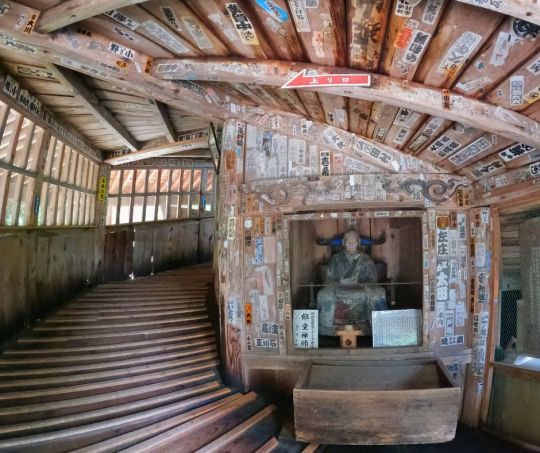
Statue of Zanmu from the Sazaedo pagoda (Fukushima Travel; reproduced for educational purposes only) As already pointed out by 9 here even before my previous post about Unfinished Dream of All Living Ghost, Zanmu is based on a real monk also named Zanmu. His full name was Nichihaku Zanmu (日白残夢), and he also went by Akikaze Dōjin, but even Japanese wikipedia simply refers to him as Zanmu. ZUN basically just swapped one kanji in the name, with 日白残夢 becoming 日白残無. The character 無, which replaces original 夢 (“dream”), means “nothingness” - more on that later.The search for sources pertaining to the historical Zanmu has tragically not been very successful. In contrast with some of the stars of the previous installments, like Prince Shotoku or Matarajin, he clearly isn’t the central topic of any monographs or even just journal articles. Ultimately the main sources to fall back on are chiefly offhand mentions, blog articles and some tweets of variable trustworthiness. The only academic publication in English I was able to locate which mentions Zanmu at all is the Japanese Biographical Index from 2004, published by De Gruyter. The price of this book is frankly outrageous for what it is, so here’s the sole mention of him screencapped for your convenience:

The book referenced here is the five volume biographical dictionary Dai Nihon Jinmei Jisho from 1937. I am unable to access it, but I was nonetheless able to cobble together some information about Zanmu from other sources. Not much can be said about Zanmu’s personal life. He was a Buddhist monk (though note a legend apparently refers to him as “neither a monk nor a layperson”, a formula typically designating legendary ascetics and the like) and a notable eccentric. Both of these elements are present in the bio of his Touhou counterpart.
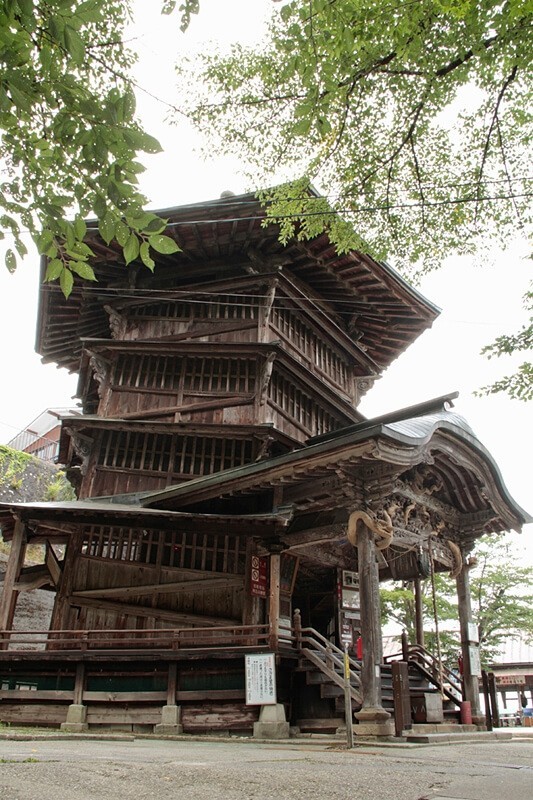
The Sazaedo pagoda (Fukushima Travel; reproduced for educational purposes only)
Zanmu’s tangible accomplishments seem to be tied to the temple Shoso-ji, which he apparently founded. He is enshrined in the Sazaedo pagoda near it, though this building postdates him by over 200 years. It’s located in Aizuwakamatsu in Fukushima. You can see some additional photos of his statue displayed there in this tweet. It’s a pretty famous location due to its unique double helix structure, and it has a pretty extensive article on the Japanese wikipedia. It’s also covered on multiple tourist-oriented sites in English, where more photos are available (for example here or here). There’s even a model kit representing it out there. Sazeado’s fame does not really seem to have anything to do with Zanmu, though. While many Buddhist figures ZUN used as the basis for Touhou characters in the past belonged to the “esoteric” schools (Tendai and Shingon), Zanmu was a practitioner of the much better known Zen, specifically of the Rinzai school.

The kanji mu (無 ) caligraphed by Shikō Munakata (Saint Louis Art Museum; reproduced for educational purposes only) Since the concept of “nothingness” or “emptiness” represented by the kanji 無 (mu) plays a vital role in Zen (see here or here for a more detailed treatment of this topic; it’s covered on virtually every Zen-related website possible though), and there’s even a so-called mu kōan, it strikes me as possible this is the reason behind the slightly different writing of the names of ZUN’s Zanmu, as well as the source of her ability. Granted, the dialogue in the games makes it sound like Zanmu (and by extension Hisami) just talks about nothingness as a memento mori of sorts, which is not quite what it entails in Zen. Of course, ZUN does not adapt Buddhist doctrine 1:1 (lest we forget Kasen seemingly being unaware of the basics of Mahayana in WaHH) so this point might be irrelevant.
The legendary Zanmu
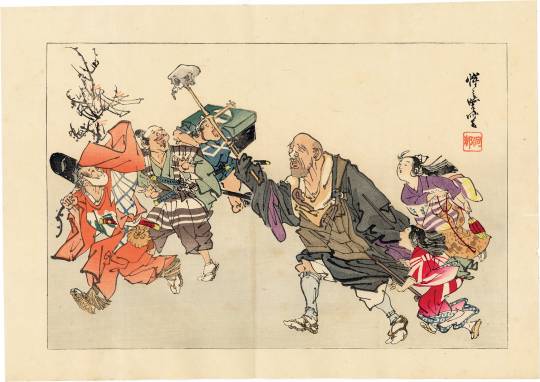
The eccentric monk Ikkyū (center), as imagined by Kawanabe Kyōsai (Egenolf Gallery; reproduced for educational purposes only)
A number of legends developed around the historical Zanmu. If this blog post is to be trusted, there is a tradition according to which he was a student of arguably the most famous member of the Rinzai school, and probably one of the most famous Buddhist monks in the history of Japan in general, Ikkyū. He is remembered as the archetypal eccentric monk, and spent much of his life traveling as a vagabond due to his disagreements with Buddhist establishment and unusual personal views on matters such as celibacy. As I already said in my previous article pertaining to Zanmu, long time readers of my blog might know Ikkyū from the tale of Jigoku Dayū and art inspired by it, though since this motif only arose in the Edo period it naturally does not represent an actual episode from his very much real career.
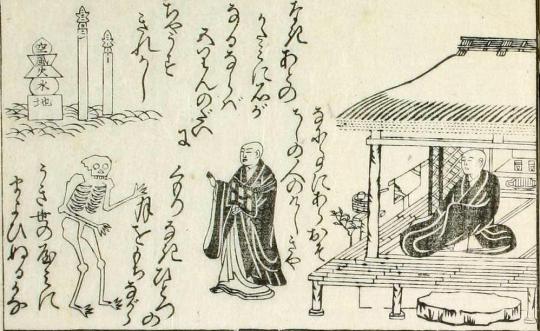
A page from Ikkyū Gaikotsu (wikimedia commons)
In art a distinct tradition of depicting Ikkyū with skeletons developed, as seen both in the case of works showing him with his legendary student Jigoku Dayū and in the so-called Ikkyū Gaikotsu. Skeletons also played a role in Zen-inspired art in general (for more information see here). Whether this inspired ZUN to decorate Zanmu’s rock with bones is hard to determine, but it does not seem implausible. It would hardly be the deepest art history cut in the series, less arcane of a reference than the very existence of Mai and Satono or Kutaka’s pose. Obviously, it does not seem very plausible that Ikkyū ever actually met the historical Zanmu. Ikkyū passed away in 1481, and Zanmu in 1576, with his birth date currently unknown. Even if we assume he was a particularly long-lived individual and by some miracle was born while Ikkyu was still alive, it is somewhat doubtful that an elderly sick monk would be preaching Zen doctrine to an infant. However, apparently legends do provide a convenient explanation for this tradition. Purportedly Zanmu lived for an unusually long time. The figure of 139 years pops up online quite frequently, and does seem to depend on a genuine tradition, but even more fabulous claims are out there.

Kaison Hitachibō, as imagined by an unknown artist (wikimedia commons)
According to another legend, Zanmu was even older, and in fact remembered the Genpei war, which took place in the Heian period - nearly 400 years before his time. Supposedly he told many vivid tales about its famous participants, Yoshitsune and Benkei. A tradition according to which he was himself originally a legendary retainer of Yoshitsune, the warrior monk Kaison Hitachibō (常陸坊海尊) developed at some point. This has already been pointed out by others before me in relation to the Touhou version of Zanmu. From what I’ve seen, some Japanese fans in fact seem excited primarily about the prospect of Zanmu offering an opportunity to connect Touhou and works focused on the Genpei war. The tradition making Zanmu a centuries-old survivor from the Heian period must be relatively old, as his supposed immortality is already mentioned in Honchō Jinja Kō (本朝神社考; “Study of shrines”) by Razan Hayashi, who was active in the first half of the seventeenth century, mere decades after Zanmu’s death. While I found no explicit confirmation, it seems sensible to assume this legend was already in circulation while Zanmu was still alive, or at least that it developed very shortly after he passed away. Perhaps he really was invested in accounts of that period to the point he sounded as if he actually lived through it.
The choice of Kaison as Zanmu’s original name in the legend does not seem random, as there was a preexisting tradition according to which this legendary Heian figure was cursed with eternal life for betraying Yoshitsune by fleeing from the battlefield instead of remaining with his lord to die. You can read more about this here. Apparently there is a version where he instead becomes immortal to make it possible to pass down the story of the Genpei war to future generations (this is the only source I have to offer though), and there's even a well-received stage play based on it, Hitachibō Kaison (translated as "Kaison, priest of Hitachi") by Matsuyo Akimoto. Another thing worth pointing out is that Kaison was seemingly a Tendai monk from Mount Hiei, which means that even though Okina isn’t in a new game, you can still claim she’s metaphorically casting her shadow over it in some way if you squint (and that’s without going into the fact sarugami are associated with Mount Hiei). I've seen two separate sources which mention that according to a legend he trained Benkei there, and that the two did not get along because Kaison was a corrupt monk (lustful, keen on substance abuse, greedy, the usual routine). You can access them here and here,but bear in mind they're old. Zanmu’s Genpei war connection does not really seem to matter in Touhou, though, as ZUN pretty explicitly situated his version in the Sengoku period, with no mention of earlier events. Granted, if you like it, this should not prevent you from embracing the view that Zanmu is an alter ego of Kaison as your headcanon - as I said people are already doing that. It seems equally fair game as “Okina is Hata no Kawakatsu”, easily one of the most popular “historical” headcanons in the history of the franchise. According to this twitter thread, the legends about Zanmu’s longevity (or immortality) have a pretty long lifespan themseles, as they were referenced by relatively high profile modern writers, like Orikuchi Shinbou and Tatsuhiko Shibusawa.
Buddhist immortals
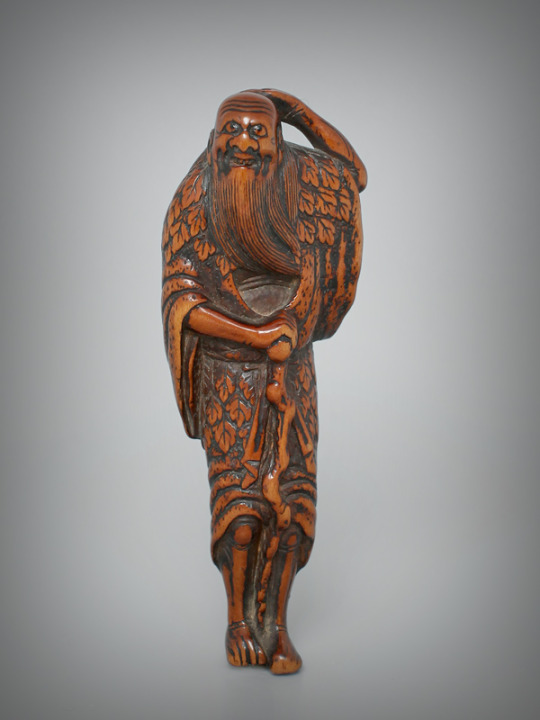
A word carving of a sennin, "immortal" or "hermit" (wikimedia commons)
Legends about long-lived (or outright immortal) monks, such as Zanmu or Kaison, are hardly uncommon. A work which seems to be the key to understanding their early development, and by extension possibly also the portrayal of Zanmu in Touhou, might be Honchō Shinsenden, “Records of Japanese Immortals”. This title refers to a collection of setsuwa, short stories typically meant to convey religious knowledge or morals. Its title pretty much tells you what to expect. Honchō Shinsenden is an interesting work in that while it in theory deals with Buddhism, and largely describes the individual immortals as, well, Buddhists, it ultimately reflects a Taoist tradition. There is a strong case to be made that it was an inspiration for another Touhou installment, specifically Ten Desires, already, seeing as it mentions prince Shotoku and Miyako no Yoshika and its Taoist-adjacent context has a long paper trail in scholarship, but I will not go too deep into that topic here - expect it to be covered in a separate article later on. Stories of immortals are pretty schematic, and their protagonists can be categorized as belonging to a number of archetypes. I think it’s safe to say this has a lot to do with the self-referential character of this sort of literature - compilers of new works were obviously familiar with their forerunners, and imitated them for the sake of authenticity. In China, literary accounts of the lives of immortals circulated as early as in the first century BCE, with the concept of immortals (xian, 仙, read as sen in Japanese; this term and its derivatives have various other translations too, with Touhou media generally favoring “hermit”) itself already appearing slightly earlier. It seems Shenxian Zhuan (Biographies of Spirit Immortals) by a certain Ge Xuan, certified immortals enthusiast and cinnabar-based immortality elixir connoisseur (discussing and developing immortality elixirs was a popular pastime for literati in ancient and medieval China), can in particular be considered the inspiration for the later Japanese compilation. While the concept of immortals was largely developed by Taoists, tales focused on them were already not strictly the domain of Taoism by the time they reached Japan. They were embraced in Chinese culture in general, both in strictly religious context and more broadly in art. In Japan, they came to be incorporated into Buddhist worldview, and in fact Honchō Shinsenden states that their protagonists can be understood as “living Buddhas” (ikibotoke), a designation used to refer to particularly saintly Buddhists. Their devotion to both Buddhas and other related figures, and to local kami, is stressed multiple times too.
Presumably this was the result of the influence of the Japanese Buddhist concept of hijiri (聖), a type of particularly rigorous solitary ascetic in popular imagination regarded as almost divine. Needless to say, most of you are actually familiar with the hijiri even if you never read about them, as this is the source of Byakuren’s surname and a clear influence on her character too. In Honchō Shinsenden, it is outright said that the sign 仙, normally read as sen, should be read as hijiri in this case.
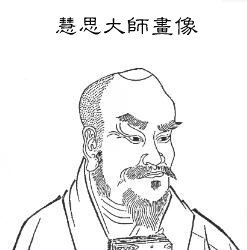
A portrait of Huisi (wikimedia commons)
The notion of extending one’s lifespan was not incompatible with Buddhism, as evidenced by tales of adepts who lived for a supernaturally long period of time to show their compassion to more beings or to get closer to the coming of Maitreya. Even the founder of the Tiantai school of Buddhism (the forerunner of Japanese Tendai), Huisi, was said to meditate in hopes of extending his life to witness Maitreya. At the same time, Chinese compilations of stories about immortals do not list Buddhists among them, in contrast with Japanese ones. This might be due to the rivalry between these religions which was at times rather pronounced in Tang China, culminating in events such as emperor Wuzong's persecution of Buddhism. Let’s return to Honchō Shinsenden, though. Its original author was most likely Ōe no Masafusa, active in the second half of the eleventh century. No full copy survives, but the original contents can nonetheless be restored based on various fragmentary manuscripts. Some of the sections are preserved as quotations in other texts or in larger compilations of stories, too. I have seen claims online that the historical Zanmu is covered in some editions of the Honchō Shinsenden or works dependent on it. So far I was only able to determine with certainty that Zanmu is covered alongside the immortals from Honchō Shinsenden in at least one modern monograph (Nishi-Nihon-hen by Kōsai Chigiri; if anyone of you have access to it I’d be interested to learn what exactly it says about Zanmu) and a number of posts and articles online. However, he lived around 400 years after this work was completed, so he quite obviously does not appear in its original version, contrary to what the Touhou wiki says right now. Masafusa does not necessarily portray the immortals as pinnacles of morality, and indeed moral virtues do not seem to be a prerequisite for attaining this status in his work. It is therefore possible that despite being setsuwa, his tales of immortals were an entirely literary endeavor and were not meant to evoke piety, let alone promote the worship of described figures.
A recurring pattern which unifies all of these tales is describing immortals as eccentric. As I already noted, this is a distinct characteristic of the historical Zanmu too, and it comes up in the bio of his Touhou counterpart as well. She has “reached the absolute pinnacle of eccentricity”. It seems safe to say ZUN is aware of that pattern, then, and consciously chose to highlight this. He also stresses that Zanmu has lived through an era of marital strife, specifically through the Sengoku period. The inclusion of such episodes is another innovation typical for Japanese immortal tales, and does appear to be a feature of the tradition pertaining to Zanmu’s counterpart too, as discussed above. Horned hermits?

A modern devotional statuette of Laozi with horns, found on ebay of all places; reproduced here for educational purposes only.
There is a further possible feature of Zanmu that might be tied to Honchō Shinsenden. While there are numerous physical traits attributed to immortals in Chinese sources, Masafusa decided to only ever highlight two. One of them are unusual bones, the other - horns on the forehead. Tragically one of my favorites, square pupils (mentioned in Liexian Zhuan), is missing. Masafusa relays that an anonymous hijiri, the “Rod-Striking Immortal”, grew stumpy horns as a sign of attaining his supernatural status.This might be a stretch, but perhaps Zanmu, due to being the Touhou version of a legendary immortal, also already had horns before becoming an oni. You have to admit it would be funny.
The two horns - or rather small bumps, based on available descriptions - characteristic for some immortals were known as rijiao (日角; “sun-horn”) and yuenxuan (月懸; “moon crescent”). Such unusual physical features were already attributed to various legendary and historical rulers and sages in China in the first century CE, so this is not really a Taoist invention, but rather an adoption of beliefs widespread in China in the formative years of this religion. They also intersected with the early Buddhist tradition about the so-called “32 marks of the Buddha”, documented for example in Mahāvastu and later in Chinese Mahayana tradition which Taoist authors were familiar with. Yu the Great, the flood hero, was among the legendary figures said to possess horns in Chinese tradition. It is even sometimes believed Laozi had them when he was born, which according to Livia Kohn was meant to symbolically elevate him to the rank of such mythical figures as Fuxi.
While this is ultimately a post focused on Zanmu, I think it’s worth pointing out this belief in horned ascetics has very funny implications for Kasen. Being a “horned hermit” is not really an issue, it would appear. If anything, it adds a sense of authenticity. Clearly Kasen needs to study the classics more.
Immortals (and mortals) in hell
One last connection between Zanmu and legends about immortals is her role as an official in hell. However, this is much less directl. Early Chinese sources mention “Agents Beneath the Earth” (dixia zhu zhe 地下主者), a rank available to low class immortals choosing to serve in the land of the dead. They could be contrasted with the immortals inhabiting heaven, regarded as higher ranked than them. However, note that there are also many narratives focused on mortals becoming officials in hell - in Japan arguably the most famous case is the tale of Ono no Takamura, a historical poet from the early Heian period. In Chinese culture there are multiple examples but I think none come close to the popularity of judge Bao. It does not seem any immortals playing a similar role retain equal prominence in culture. Ultimately this paragraph is only a curiosity, and a much closer parallel to Zanmu's role in hell exists - and it’s connected to materials ZUN already referenced to booth.
Corrupt monks, oni and tengu
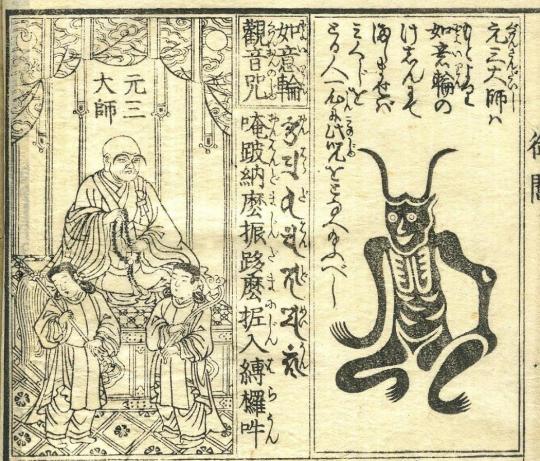
Ryōgen, the most famous monk turned demon, and his alter ego Tsuno Daishi (wikimedia commons)
In addition to characterizing Zanmu as eccentric, ZUN also wrote in her bio that she is a corrupt monk. As we learn, she developed a belief that the best way to reconcile the Sengoku period ethos which demanded boasting about the number of enemies killed with Buddhist precepts was to focus on spirits rather than the living, since she will basically deliver salvation to them. She ultimately “absorbed some beast-youkai spirits, thus discarding her life as a human”. This to my best knowledge does not really match any genuine tradition about the historical Zanmu, related figures or anyone else. As far as I can tell, it’s hard to find a direct parallel either in irl material or elsewhere in Touhou... at least if we stick to the details. More vaguely similar examples are not only attested, discussing them was for a time arguably the backbone of Buddhist discourse in Japan, and neatly explains why Zanmu became an oni. The idea that monks who broke Buddhist precepts in some way turned into monsters is not ZUN’s invention. It first appears in sources from the Heian period, and gained greater relevance in the Kamakura period. Particularly commonly it was asserted that members of Buddhist clergy who fail to attain nirvana turn into tengu. However, oni were an option too. Bernard Faure points out that Ryōgen, the archetypal example of a fallen monk (see here for a detailed discussion of this topic, and of his return to grace as a demon keeping other demons at bay), could be described as reborn as an oni, for example. The Shingon monk Shinzei is variously described as turning into an oni, a tengu or an onryō (vengeful spirit). Oni are also referenced in a similar context in Heike Monogatari alongside tenma, a term referring to demons obstructing enlightenment in general.

Corrupt monks turned into tengu in the Tengu Zoshi Emaki (wikimedia commons)
Typically it was believed that monks who turned into demons went to a realm variously known as makai, tengudō or madō. As you may know, normally there are three realms one should avoid reincarnating in - beasts, hungry ghosts and hell - but this was basically a bonus fourth one. Granted, this view was not recognized universally, and the alternative interpretation was that it was just a specific hell with a distinct name. At the absolute peak of this concept’s relevance, the foremost Buddhist thinkers of these times, including Nichiren, were accusing each other of being demons. Additionally, some of the past emperors, especially Sutoku and Goshirakawa, could be presented as tengu, for example in Hōgen monogatari. There was also an interest in finding gods who could keep the forces of disorder at bay. You can see echoes of these beliefs in rituals pertaining to Matarajin, which ZUN rather explicitly referenced in Aya's route in Hidden Star in Four Seasons. Typically the reason behind transformation into an oni, tengu or another vaguely similar being were earthly attachments. Alternatively, it could be pursuing gejutsu, “outside arts”, essentially teachings which fell outside of what was permitted by Buddhism. Note this does not necessarily mean anything originating in religions other than Buddhism, though, the term is more nuanced. So, for instance worship of kami or following Confucian values are perfectly fair game. A synonymous term was gedō, “heretical” way (on the use of the term “heresy” in the context of study of Buddhism see here). We can make a case for Zanmu’s bio alluding to that - she wanted to adhere to the social norms of the Sengoku period by symbolically taking in a headcount by absorbing spirits, I suppose. That’s not really a thing in any Buddhist literature, though, and I assume ZUN came up with this himself. Conclusion While this article is slightly less rigorous than my recent research ventures pertaining to Matarajin, let alone the Mesopotamian wiki operations, I hope it nonetheless sheds some additional light on Zanmu. I will admit I already liked her even before I started digging into the possible inspiration behind her, and finding out more only strengthened my enthusiasm. While there are clear parallels between Zanmu, her namesake and a variety of other characters from Japanese and Chinese literature and religions, as usual for a character made by ZUN her strength lies both in creative repurposing of these elements and in adding something new.
Postscriptum: Zanmu and Tang Sanzang?

Xuanzang, as depicted by an unknown Qing artist (wikimedia commons) While much about Zanmu’s character - her backstory as an eccentric fallen monk who became a demon, her apparent zen theme, and so on - all form a coherent whole, there is a tiny detail which does not really match anything else discussed in this article. It does not come from her dialogue or bio, but rather from Enoko’s. As we learn, she became immortal herself after eating a piece of Zanmu’s body back when the latter was still a human. Or rather, the combination of that and subsequently consuming a magical gemstone as recommended by Zanmu did it - I’m pretty sure I misread this before. As 9 pointed out to me, probably the implications are just that Enoko’s backstory is a partial reference to Perfect Memento in Strict Sense, which does state that consuming the flesh of a monk would be a particularly suitable way for an ordinary animal to turn into a youkai. Still, comparisons between this tidbit and Journey to the West have been made by others before already, so I figured it would be suitable to address them here even if they lie beyond my own argument about the inspiration behind Zanmu. In this novel, many demons want to devour its protagonist Tang Sanzang because his flesh is said to make anyone who consumes immortal. This is because he is a reincarnation of Master Golden Cicada (Jinchan zi, 金蟬子), a disciple of the Buddha invented for the sake of the story. Interestingly, Sanzang is portrayed as an adherent of Chan Buddhism, the school from which Japanese Zen is derived (note that his historical forerunner Xuanzang belonged to the Yogācāra tradition instead). Despite the vague similarities, I ultimately do not think there are particularly close parallels between Zanmu and Sanzang. For starters, Zanmu is meant to be a corrupt monk, while Sanzang is the opposite of that. Their respective characters couldn’t differ more either. Throughout the entire novel, Sanzang is a pretty poor planner, shows doubt in his own abilities, and regularly misjudges the situation. Needless to say this does not exactly offer a good parallel to Zanmu. Sure, she creates a bootleg Wukong, but Sanzang did not create Wukong, the famous primate was just assigned to him as a bodyguard. Therefore, until evidence on the contrary appears (for example in an interview) I would personally remain cautiously pessimistic regarding a possible connection here. Recommended reading
Bernard Faure, Rage and Ravage (Gods of Medieval Japan vol. 3)
Noga Ganany, Baogong as King Yama in the Literature and Religious Worship of Late-Imperial China
Zornica Kirkova, Roaming into the Beyond: Representations of Xian Immortality in Early Medieval Chinese Verse
Christoph Kleine & Livia Kohn, Daoist Immortality and Buddhist Holiness: A Study and Translation of the Honchō shinsen-den
Livia Kohn, The Looks of Laozi
James Robson, The Institution of Daoism in the Central Region (Xiangzhong) of Hunan
Haruko Wakabayashi, From Conqueror of Evil to Devil King: Ryogen and Notions of Ma in Medieval Japanese Buddhism
Idem, The Seven Tengu Scrolls. Evil and the Rhetoric of Legitimacy in Medieval Japanese Buddhism
265 notes
·
View notes
Text
Hey, so this is going to be very out of character for me, but I need help finding sources that prove that Trump wanted to ban TikTok back in late 2019/early 2020. I can find news sources and Wikipedia articles saying as much, but I would really prefer if I could find like, a clip or something of him actually saying it.
Im not good at doing political research, I've never really looked into it all that much (a decision I really regret now) and now I need either tips on how to find what it is I want, or just clips of him mentioning this, or some other more 'trustworthy' source backing this stuff up.
Here are some screen shots from three different sources that I have linked below the cut.




#I may or may not be fighting my father#who believes Trump is a good politician who only has good intentions#also he doesn't listen to me when I say TikTok was unbanned partially because of rednote#but that's neither here nor there#us politics#tik tok ban#fuck trump#donald trump#joe biden#republicans#democrats#united states#God i am so sure I'll attract the wrong people please tiktok#gay#transgender#there hopefully that helps?#I hope.im not fucking myself over with these tags
19 notes
·
View notes
Text
I reblogged a post about how the EPA creating shelter-in-place orders only at night wasn't supporting capitalism, it was responding to the real situation caused by weather events, BUT.
I think the real issue is that the government has destroyed its trust and credibility.
The American government has, repeatedly, created policy that values capitalistic profits over human lives. This was not limited to the Trump administration, although they certainly did that. It has persisted throughout the history of the United States, because this has always been a capitalist country.
Yet in recent years, due to the speed of communication and the erosion of trustworthy sources, more and more people distrust government agencies. Hell, I distrust them.
And this, crucially, is a massive failure of government. The point of government is to create and support systems that protect the way of life of their people. The only people protected by the American government are the 1%.
So I don't fault you for believing the idea that the EPA was deliberately putting people at risk to ensure business as usual. You have been lied to, manipulated, and in other ways let down by the government.
Unfortunately, until the American government undergoes such a thorough overhaul that its agencies are trustworthy, that does mean you are required to critically evaluate criticisms of its policies. You have to consider whether they are based in truth or fearmongering. This is doubly true when they both seem to uphold what you already believe and when they make you feel disgusted, horrified, or scared.
And one of the best ways to do this is to learn about stuff. Not the specific policies themselves, when you come across them. Just stuff in general. I spotted the falsehood of that fearmongering about the EPA immediately simply because I have learned enough about weather to understand nocturnal temperature inversions.
Just, like, browse articles on Wikipedia. Peruse Encyclopedia Britannica. Go to their sources and read those. Read nonfiction books. Read your local news.
Arm yourself against misinformation. Learn about stuff.
23 notes
·
View notes
Note
I am source
>:O
I am always very funny
9.2
Im going to need a source for that one
12 notes
·
View notes